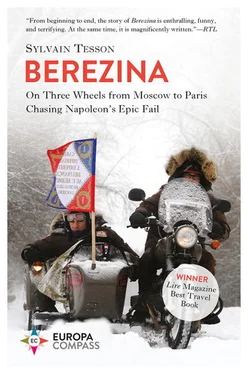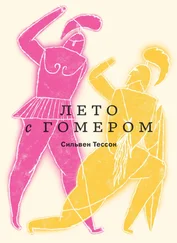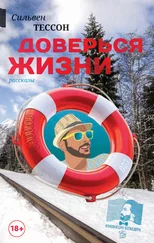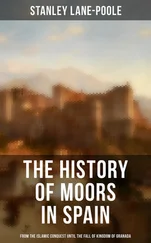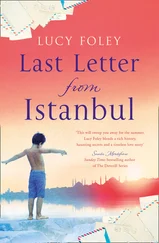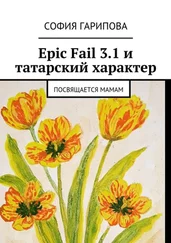On the morning of the 29th, the horror rose to a new level when Napoleon ordered Éblé to destroy his work. Marshal Victor, who formed the French rear guard, had crossed over the night before and the final pieces of artillery had been brought over during the night. At dawn on the 29th, the Russians had to be cut off from crossing the Berezina. As soon as the flames rose, there was one final rush. The screams covered the cannon fire. Those who were still on the other bank threw themselves into the blaze or the water. They could choose to die in either of these opposite elements.
We were mesmerized by the spectacle of this valley. We were standing in the snow and none of us dared move. There were peasants haranguing a horse on a nearby path. The horse lent the landscape an air of bygone times. They drove past us, sitting on a cart. The snow embellished the edge of the forest and muffled the ringing of the little bells. The cart disappeared in the fine hail. Gras touched my arm, “You see, this is a top location.”
“What do you mean?”
“A top location,” he replied, “is a stretch of geography fertilized by the tears of History, a piece of territory made sacred by an act, cursed by a tragedy, a land that, over the centuries, keeps echoing with hushed-up suffering or past glory. It’s a landscape blessed by tears and blood. You stand before it and suddenly sense a presence, a surge, a manifestation of something you can’t quite put your finger on. It’s the echo of History, the fossilized radiation of an event that seeps out of the soil, like a wave. Tragedy has been so intense here, and in such a short space of time, that the geography hasn’t recovered yet. The trees may have grown but the Earth continues to suffer. When it drinks too much blood it becomes a top location. Then you must look at it in silence because it’s haunted by ghosts.”
Even Goisque had stopped taking photos of the world. The snowy fields were dotted with monuments dedicated to the memory of the two armies. A stela bore the name of a man of whom charity obliges us to conceal his name and only refer to him as F.B. It was he who ordered the monument—and maybe financed it—and made sure this was known. Why didn’t he erect a commemorative stone with the following sentence engraved: “Here, where I have laid this slab, Napoleon passed with his entire army”?
The monument made me think of that TV journalist to whom I announced, live, a few months earlier, that I wished to retrace the steps of the Retreat, and pass through the Berezina. “Napoleon? The Berezina? That’s not very glorious,” was her comment.
Here, before the river grave, the words I should have said back to her came to my lips. But, once again, I had been the victim of staircase wit.
“Really, my dear? You don’t think there’s any glory in the bridge builders who accepted death so that their companions might cross over? Or in Éblé, the gray-haired general who crossed the bridge several times under cannon fire in order to report to the Emperor the progress of the rescue, and who died from exhaustion a few days later? Nothing glorious about Larrey, the chief surgeon who made countless trips back and forth between banks in order to save his surgical equipment? Or about Bourgogne, who gave his bearskin to a shivering soldier? Or about the sappers who threw ropes to the wretches who’d fallen into the water, or about the women about whom Bourgogne writes that ‘they shamed some of the men, by bearing with admirable courage all the suffering and deprivations they were subjected to’? Or about the Emperor who saved forty thousand of his men, and about whom the Russians had sworn three days earlier that he didn’t have a chance in a million to escape them? What is glory for you, Madame , if not the warding off of horror through heroic deeds?”
Instead, I had stammered, “Er, well, actually…”
The rest of the journey, toward Lithuania, was a marvel. At times, we would glide through cream-colored woods. Suddenly, the road would penetrate citadel-forests with high peaks, and pine trees would erect walls of bronze, made faintly white by scattered patches of snow. Had a procession of elves crossed before our wheels, we wouldn’t have been in the least surprised. Goisque and I took it in turns driving and being a passenger. In the zinc coffin of the sidecar, one was free to think. Or rather to daydream. I remember the mountain climber Reinhold Messner as he was crossing the Antarctic. As he pulled his pulka , he confessed he killed entire hours with erotic fantasies. We were driving toward Smorgon and trying to cover as much road as possible before dark. Full bellies, Moldavian dancers, and rosy thighs were dancing before my eyes.
“Tesson, what are you thinking?”
“About top locations,” I replied.
Gras’s theory about top locations was a good one. Between the villages of Pleshnitzy and Viliejka, since I had a hour to kill lying in my cold room on wheels, I tried to picture a typology of top locations, and identified six types:
The top locations of tragedy : they had been the settings for battles. The whisperings of History resounded there like an echo. For me, these top locations were Confrécourt, the plowing fields of the Soissonnais region, Masada, and Stalingrad.
Spiritual top locations : these were places historian Maurice Barrès described as “where the spirit blows, locations that pull the soul out of its lethargy,” stelas where the Earth touched the Sky, and were, as magi used to say, consecrated. Gods roamed there. The Ancient Greeks would erect temples in these mythical settings. For me, these places were the heights of Lhasa, where the city opened up like a flow of gold at the bottom of the pan, the Ménez-Hom, which bolted the tricuspid point of the Crozon peninsula, the peak of the Drus, where a Blessed Virgin subject to lightning bolts kept watch.
Geographical top locations : these didn’t need any help from Man. Their natural architecture and formal beauty spoke for itself. For me, these peak locations were Lake Manasarovar, the Kailash mirror, the source of Syr Darya in the heights of the Heavenly Mountain, the cliffs of the Ustyurt Plateau, by the Aral.
The top locations of memory : these were the graves of our friends or heroes. You would stand on the exact spot where they had died. For me, these peak locations were the shoulder of a road in Afghanistan where companions I was fond of died in my arms, the building on an embankment of the Seine, where a Jewish philosopher with an exalted voice lived his final days, the plowing fields of Villeroy, where Péguy was killed with a shot in the head.
The top locations of creation : these were not spectacular places but gardens, houses, and even ruins. There, in the shade of the trees, in the silence of an office, artists had composed everlasting works. For me, these top locations were the walls of Nicolas de Staël’s country house, the silent rooms of Anna Akhmatova’s apartment in Saint Petersburg, and the cafés of Rue de la Huchette where the shadows of Huysmans and Jean Follain roamed.
The top Heraclitean locations : these were places with physical contrasts. Locations for the old Ephesian wise man. He believed that “everything is born from discord,” and that “any contrariety is beneficial.” In geographical terms, these had to be places where there’s a marriage of elements, where water meets rock, where light fertilizes the sea, where the wind hisses in the trees. The walls of Calanques de Cassis belonged to these top locations.
It was bitterly cold and we were soaked. Moreover, in his sidecar, Gras was beginning to find time a drag. In the Pleshnitzy service station, where we stuffed our machines with seventy-two octane gas, he started moaning. “Hey, guys, you sold me a picnic in a comfortable sidecar where I was supposed to be able to read and write.”
Читать дальше
